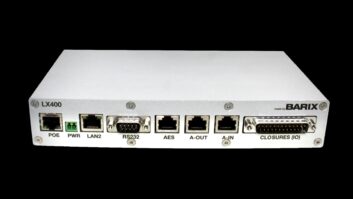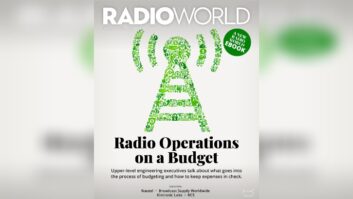When telephone companies decided to pioneer the digital landscape in favor of voice routing, they unwittingly paved the way for the most dramatic paradigm shift in radio broadcasting since Marconi’s findings.
The present ubiquity of wideband connectivity allows any radio station easily to report from virtually anywhere in the world with vibrant sound quality and at a nominal (if any) fee.

Many of us may remember the squeaking voices that allowed radio listeners to be a part of sports events, where their village’s team was trying to do its best.
Live sport commentaries from remote locations originally required much effort and a number of resources that only few broadcasters (usually national or public-service ones) could handle. The use of PSTN telephone lines, paired with sometimes home-built telephone hybrids, subsequently allowed budget-minded, local radio stations to join in on the live sport commentaries.
RADIO LINK vs. PHONE BOX
At the same time, the number of teams that could benefit from this long-range visibility bumped up, and also thanks to the increased reach of radio commentaries, the popularity of various sporting events increased.
Point-to-point connections via analog radio links, often requiring some “hops,” allowed sharp and natural voice contributions and remained a trait of large-budget broadcasters for many years.
However, during the analog era, breaking news was often capable of reverting all broadcasters to the same level: When something unexpected happened in a rural location, there typically was no way to have a radio link van and crew in place and ready to cover the event immediately. Under those conditions all broadcasters were on equal terms, and a phone box was the common hardware reporters could rely on.
Initially broadcasters had to choose between two options. Radio links ensured high-quality and dedicated connections from the field to the studio but they required a remarkable amount of time to be moved on site and be deployed, as well as a properly staffed crew with the associated operating cost.

Remote contributions via PSTN, on the other hand, implied a compromise on voice quality and shared transmission resources with other users (telecom infrastructures), but they were available nationwide, very cost-effective and fast to set up once the reporter is in place, even from abroad.
The advent of (voice) mobile telecommunication networks pushed the availability of telephone-routed contribution a step further, yet voice quality remained nothing more than an acceptable compromise.
BIGGEST REVOLUTION
For a long time there has been no third way: It was either quality or agility, and budget-focused stations did not have the “quality” option. ISDN connections bridged the gap some. For the first time, they allowed broadcasters to achieve a very good sound quality without having to use radio links.
ISDN lines were available at pre-determined locations, for example at a sports arena, but were hardly available at random locations for breaking news reporting. ISDN connections succeeded in bridging the gap as regards operating costs but not for availability.
In the late 1980s, telephone operators embarked upon their digital revolution. At first, they moved their backbone networks to a digital-only zone, and then they gradually migrated all branches of their access networks to digital technology. From the year 2000, digital lines finally reached end users’ premises. At the same time, mobile telephone networks gained remarkable data transmission capacity, thanks to both the new transmission standard (3G, unleashing large last-mile throughput) and the previous implementation of digital backbone networks, capable of managing and delivering an unprecedented volume of data.
Probably the biggest revolution in the history of telecommunications after Marconi’s findings took place silently; but that digital, universally available infrastructure dramatically changed the way broadcasters manage contribution.
IP audio and video delivery on mobile and wired networks broke down the previous barrier between broadcast quality and agility: Even better sound quality than with analog radio links could be achieved from almost everywhere thanks to portable, light and battery-powered equipment. Even high-quality reporting on the move, which previously required a bridging connection through an helicopter, became as fast and cheap as placing a phone call.
CREATIVE POTENTIAL
Radio producers immediately realized the creative potential of the medium’s new omnipresence, deploying street reporting, pop-up stations, coverage of niche events and new and more keys to the staff, enabling stations to play an improved role.
Today, modern IP codecs range greatly in size, performance and price. They are able to unleash the creative potential of a radio station, yet tech managers have to analyze and configure the specific performance and features best suiting their workflow. Operational agility is key to any station, and the proper choice of a specific codec device can speed up and ease the rest of the process.
[Read: Nordjyske Medier Covers Northern Denmark With Remotes]
Depending on a station’s available staff and skill, the optimal choice in codec can vary from a compact, one-button model with few field-adjustable parameters (to prevent possible misconfiguration) to a rack-mounted device that is highly configurable and capable of ensuring exemplary sound performance no matter the environment but requires properly skilled staff.
Sports presenters can benefit from specific gear, including a codec and a mixer integrated into a single unit, while the possibility to download a smartphone app can turn the personal device of a remote host into a perfectly fit-for-purpose interview mic.
Low latency is key to ensuring live interaction among people sitting at multiple locations and connected via IP codecs. The ability of a codec system to preserve a low latency even when the available bandwidth is squeezed down or even suddenly varies due to local telephone network conditions brings great advantage to users.
[Read: A Love-Hate Relationship With SIP]
Advanced codec models include dual link capability or other ways of recovering as many lost packets as technically viable. This feature, of course, is always highly desirable; but it becomes necessary when codecs replace STL links.







